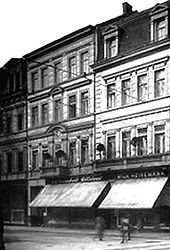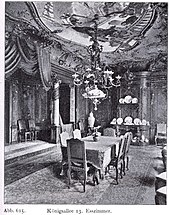Königsallee 13
The house at Königsallee 13 in Düsseldorf was built in 1879, because in 1878 the property at Canalstrasse 6, later referred to as No. 4, was still undeveloped. Originally it was characterized by an elaborate interior design, in which well-known artists such as the architects Jacobs & Wehling and the painter Hermann Pohle (ceiling paintings) participated. In 1913 the building was rebuilt under the direction of the neighboring luxury hotel Breidenbacher Hof ; The shop on the ground floor was redesigned and the upper floors adapted for hotel purposes. The elaborate interior design was lost when the Hotel Breidenbacher Hof was rebuilt according to plans by the architect Emil Fahrenkamp in 1928. The building itself was destroyed in World War II. After the new construction of the Breidenbacher Hof Hotel after 2000, the parts of the building on the former property No. 11 and 13 on the west side of Königsallee are now designated as No. 11 and 15, as the old "No. 13 “is no longer used.
Location and surroundings
At the time of construction, the building was on Canalstrasse , which was laid out at the beginning of the 19th century parallel to the city moat on its western side as far as Benrather Strasse . Until the beginning of the 20th century, it was one of the "selected residential areas" of Düsseldorf. A photograph shows the four-story building at Königsallee 13 together with the Tietz department store . In 1905 Canalstrasse was renamed Königsallee , just like the eastern side of the city moat .
history
In 1873, the address Canalstrasse No. 6, later referred to as No. 4 around 1880, is listed in the Düsseldorf address book and stated as "undeveloped". In 1881 there was a change of ownership, as the Düsseldorfer Baubank became the owner of the properties at Canalstrasse 3 and 4. In the same year, the Baubank erected a building on property 4, which was previously undeveloped, in which both the bank's head office and the residence of the bank director were located.
In 1905, the last year when the name of Canalstrasse had not yet been renamed Königsallee at the beginning of the year, there is already evidence that the 2nd floor in house No. 4 was used by the Hotel Breidenbacher Hof. From the same year, all of the upper floors of the building at Canalstrasse 3, corner building on Bazarstrasse, were also used by this hotel. In 1912 the ground floor of the building at Königsallee 13, which was still owned by Düsseldorfer Baubank, was rebuilt under the management of the Breidenbacher Hof "into a modern shop for the time." The upper floors were still used for hotel purposes. During the renovation according to plans by Emil Fahrenkamp, the interior was removed; the shop was retained. The old ashlar facade was removed and replaced by a modern cladding made of Ettringer tuff stone. The windows and doors received “simple and finely structured frames”. The building was destroyed in the air raids on Düsseldorf during World War II.
Building description
The house was characterized by its representative dining room with its valuable interior design. The architects Jacobs & Wehling had extended the dining room using old paneling. Hermann Pohle created the ceiling painting. The model for elaborate interior design in Düsseldorf was the interior of Benrath Palace : “The pursuit of intimacy and comfort determined the interior design of the houses; Above all, Benrath Castle may have served as a model ”. Paul Sültenfuß quotes Edmund Renard : “[when] studying interior design [...] the great importance of Benrath palace building for the Düsseldorf residential building [...] Edmund Renard has the charm of this in his Benrath monograph, even more than in the exterior architecture Spaces and their significance for residential building aptly characterized [...] "
Web links
Individual evidence
- ^ In: Address book of the Lord Mayor's Office in Düsseldorf. II. Directory . 1878, p. [186] 16.
- ^ Hugo Weidenhaupt: Brief history of the city of Düsseldorf. Triltsch Verlag, Düsseldorf 1993, page 495.
- ^ In: Address book for the city of Düsseldorf and the mayor's offices . The last time it was referred to in the attached city map from 1905 as Kanalstrasse.
- ^ In the address book of the Lord Mayor of Düsseldorf for 1873. II. Directory . S. [168] 12.
- ↑ Online version In: Address book of the Lord Mayor's Office in Düsseldorf. III. Part . 1881, p. [314] 122.
- ^ In: Address book for the mayor of Düsseldorf and the mayor's offices. 3. part 3. Under K analstraße . 1905, Schwann, p. [816] 198.
- ↑ a b The art of finding a hotelier. In: The Breidenbacher Hof. A legend from Düsseldorf. Its art and its history. (Ed. by Hotel Breidenbacher Hof Düsseldorf on the occasion of its 175th anniversary) Düsseldorf 1991, p. 135.
- ↑ Th. Huneke: The redesign of the palace hotel Breidenbacher Hof in Düsseldorf. In: Emil Fahrenkamp, Theodor Huneke, Hugo Schmölz: Palace Hotel Breidenbacher Hof after the renovation by Prof. E. Fahrenkamp Düsseldorf. 2nd edition, Verlag Josef Kolvenbach, Düsseldorf 1928.
- ↑ The Breidenbacher Hof. A legend from Düsseldorf. Its art and its history. (published by the Hotel Breidenbacher Hof Düsseldorf on the occasion of its 175th anniversary) Düsseldorf 1991, p. 290 (photo of the destroyed house)
- ↑ Bomb damage at Breidenbacher Hof and the Kaufhof on Königsallee. Photo: Dolf Siebert, November 1943.
- ^ Bomb damage on Königsallee in November 1943; Photographer: Dolf Siebert; Bomb damage on the west side of Königsallee after the air raid on November 3rd, 1943. On the right the Kaufhof, in front of it the ruins of the Hotel Breidenbacher Hof. Sign . : 127-477-003 .
- ^ Architects and Engineers Association in Düsseldorf (ed.): Düsseldorf and its buildings. L. Schwann, Düsseldorf 1904, p. 389 and p. 397. (Fig. 615 Königsallee 13, dining room; Fig. 616 Königsallee 13, fireplace in the dining room)
- ^ Hugo Weidenhaupt: Brief history of the city of Düsseldorf. Triltsch Verlag, Düsseldorf 1993, page 76.
- ↑ Sültenfuß, p. 92
- ↑ Edmund Renard: The New Castle at Benrath. Insel-Verlag, Leipzig 1913. (= annual edition of the German Association for Art Research , 1913.)
Remarks
- ↑ No. 2 and 4 Canalstraße were originally used for the grammar school until the 1880s and the properties south of Bazarstraße were designated accordingly with 5 and 6 before they were changed to No. 3 and 4 in the 1890s.
- ^ The Düsseldorfer Baubank was the owner of the buildings at Canalstrasse 3, 4, 5, 6 and 7, which were renamed after 1905 to Königsallee 3 to 9 (building of the Tietz department store) as well as 11 and 13. At that time, the building of the palace hotel Breidenbacher Hof also belonged to the Düsseldorfer Baubank from 1872 (evidence: In address book for the city of Düsseldorf and the mayor's offices. Part 3. 1910, p. [831] 201).
Coordinates: 51 ° 13 ′ 31.3 " N , 6 ° 46 ′ 41.3" E





